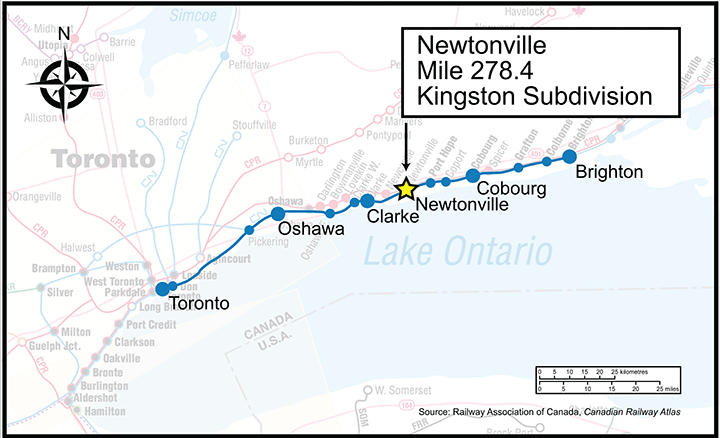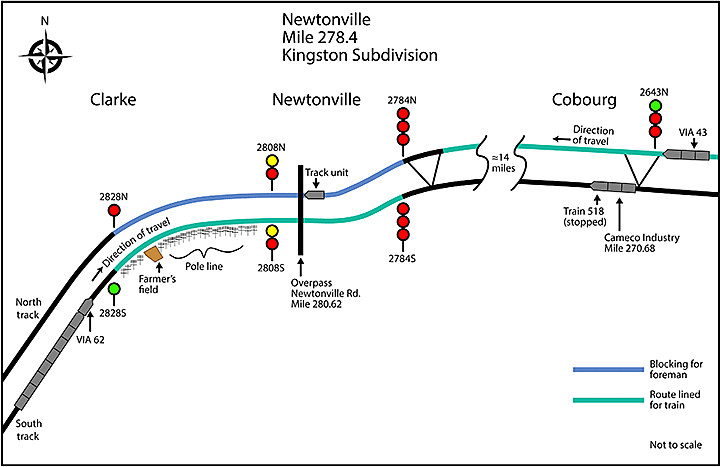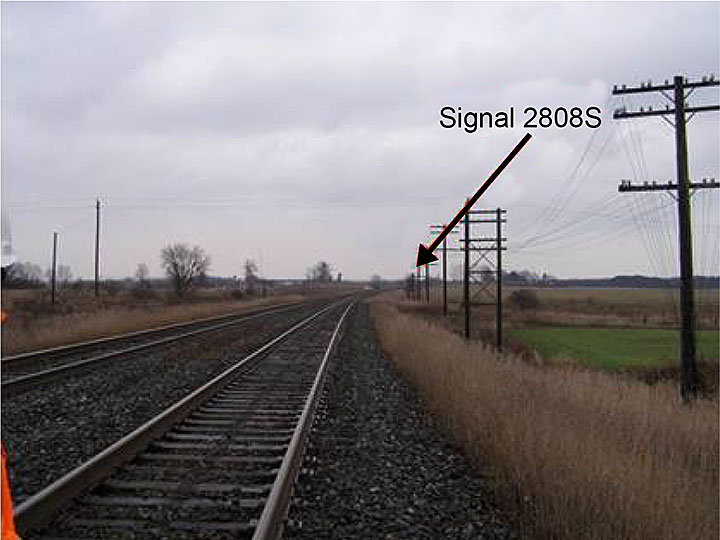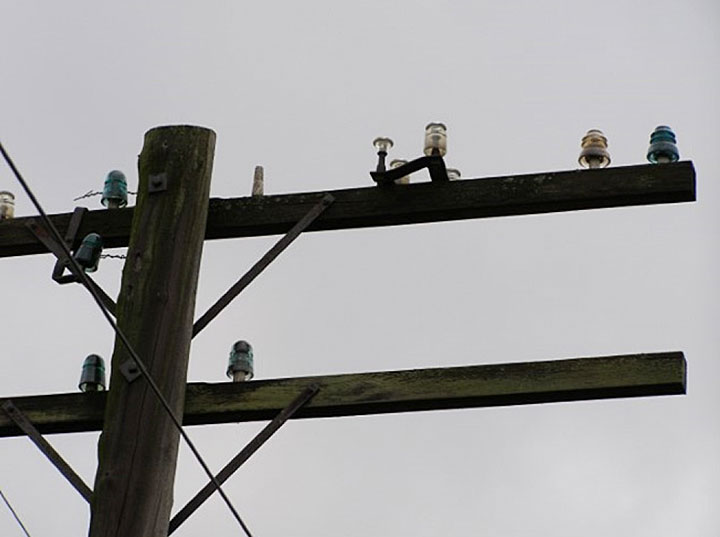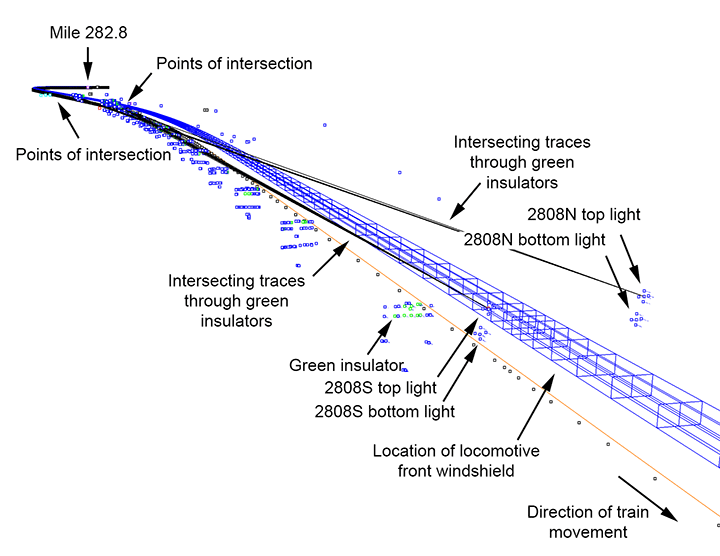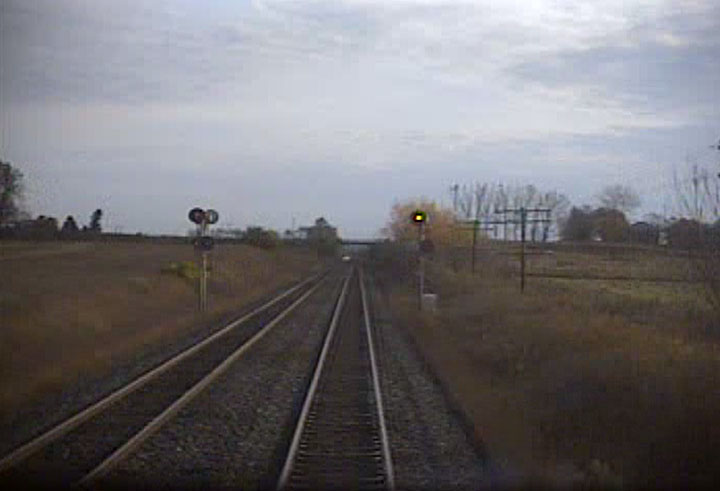Signal passed at stop
VIA Rail Canada Inc.
Passenger train no. 62
Mile 278.4, Canadian National Kingston Subdivision
Newtonville, Ontario
The Transportation Safety Board of Canada (TSB) investigated this occurrence for the purpose of advancing transportation safety. It is not the function of the Board to assign fault or determine civil or criminal liability. This report is not created for use in the context of legal, disciplinary or other proceedings. See Ownership and use of content. Masculine pronouns and position titles may be used to signify all genders to comply with the Canadian Transportation Accident Investigation and Safety Board Act (S.C. 1989, c. 3).
Summary
On 28 October 2014, VIA Rail Canada Inc. passenger train No. 62 was proceeding eastward from Toronto, Ontario, to Montréal, Quebec, on the south track of the Canadian National Kingston Subdivision near Newtonville, Ontario. At 1015 Eastern Daylight Time, VIA 62 passed Signal 2784S displaying a stop, while travelling at about 68 mph. The train was brought to a stop and an emergency radio call was broadcast. The lead locomotive passed the Stop signal by approximately 900 feet. There were no injuries, and there was no derailment or track damage.
1.0 Factual information
On 28 October 2014 at 0755,Footnote 1 the train crew for VIA Rail Canada Inc. passenger train No. 62Footnote 2 (VIA 62) came on duty. Before departing Toronto at 0925, a pre-departure briefing was provided to the crew members. During the briefing, the discussion included a review of the condition of the equipment, wheelchair requirements and radio reliability checks. The train consisted of 2 locomotives (914, 909) and 7 passenger coaches. There were about 200 passengers and 7 on-board service personnel on the train.
Canadian National (CN) train 518, a local switching assignment, was performing switching operations near Cobourg, two stations east of Newtonville (Figure 1). At about 0953, the rail traffic controller (RTC) called train 518 on the train standby channel, requesting that the crew contact the RTC before leaving, to cancel an authority. Train 518 was switching in the north yard at Cobourg as was common practice for this assignment. VIA 62's crew overheard this exchange. At about 1004, after cancelling the authority on the RTC's channel, train 518 departed Cobourg from the north track and crossed over onto the south track, westbound, destined for Cameco Industry (Mile 270.68), near Port Hope, Ontario. VIA 62's crew was unaware that train 518 was approaching on the south track from Cobourg (Figure 1). At about 1011, VIA 62's crew identified and called the intermediate signal (Signal 2828S at Mile 282.8) as a Clear signal (single green light).
The Kingston Subdivision is patrolled every second day for potential track defects. On the day of the incident, a track supervisor, who was conducting the track patrol, obtained a track occupancy permit from the RTC for the north track between Newtonville (Mile 278.4) and Clarke (Mile 286.9).
At about 1013 as VIA 62 was approaching the next signal (2808S), the track supervisor's hi-rail vehicle was visible beyond the signal on the north track just east of the overpass at Newtonville Road. VIA 62's crew noted that the advance signalFootnote 3 (2808N) to the controlled location at Newtonville for eastward trains on the north track was displaying a Clear to Stop (yellow over red) indication. Shortly afterward, in the vicinity of the Bellamy Road crossing (Mile 281.13), VIA 62's crew identified their advance signal (2808S) to the controlled location at Newtonville as a Clear signal (green over red) (Figure 2).
After the crew called the advance signal, they activated the engine bell to warn the track supervisor that they were approaching on the south track. As the train passed the hi-rail vehicle's location, the crew members established visual contact with the track supervisor.
The RTC had not yet lined VIA 62 into the controlled block at Newtonville (Signal 2784S). The RTC's plan was to line VIA 62 on the south track from Newtonville to Cobourg, after train 518 cleared at Mile 270.68 (Cameco industry) in Port Hope. The RTC did not communicate to VIA 62's crew that they may be temporarily delayed at Newtonville, waiting for train 518 to clear, nor was there any requirement to do so.
At 1014:49, while VIA 62 was travelling at about 88 mph traversing a 1-degree right-hand curve, the crew observed the Stop signal and immediately initiated an emergency brake application. At 1015:11, while travelling at 68.3 mph, VIA 62 passed the Stop signal at Signal 2784S. At about 1015:15, VIA 62's crew broadcast an emergency call announcing that they had passed the Stop signal. At 1015:35, VIA 62 came to a stop approximately 900 feet past the Stop signal. VIA 62 stopped in a distance of about 3100 feet.
The RTC immediately protected the situation by blocking the surrounding signals at Stop. At 1018:47, the crew of train 518 advised the RTC that their train was clear of the south track at Mile 270.68 and that the switch had been lined and locked back to normal. At 1025, the RTC issued a pass stop authority to VIA 62.Footnote 4
VIA Rail passenger trains are normally operated by 2 qualified locomotive engineers, both located in the lead locomotive. The operating locomotive engineer (LE) sits at the controls on the right side of the locomotive cab while the in-charge locomotive engineer (ICLE) sits on the left side of the cab and performs the duties of the conductor.
The LE for VIA 62 had more than 30 years of railway experience, including 7 years as a locomotive engineer. He had 5 years of experience with CN before moving to VIA Rail where he had worked for 2 years prior to the occurrence. The ICLE had 33 years of railway experience, including 28 years as a locomotive engineer, initially with CN before moving to VIA where he had worked for 3.5 years prior to the occurrence. The LE and ICLE were qualified for their positions, met rest standards and were familiar with the territory. They had worked together as a crew on a regular basis over the previous 6 months.
On the day of the incident, a 3rd operating crew member was also in the cab. This crew member was a qualified locomotive engineer who was making a familiarization trip. The 3rd person in the cab is usually seated in the jump seat located between the LE and the ICLE. However, that day, it was decided that he would assume the position of the ICLE, so he sat on the left while the ICLE sat in the middle seat. When a 3rd crew member is present, signal recognition and rules compliance are responsibilities shared equally among all crew members. In this occurrence, prior to reaching the controlled signal at Newtonville, the train crew had been discussing the location of the controlled signal for training and familiarization purposes.
The third crew member had 32 years of railway experience, including 16 years as a locomotive engineer. With VIA, he had been working as a qualified LE since September 2012, and had been transferred to the Kingston Subdivision in October 2014. As part of VIA's locomotive engineer familiarization program, the 3rd crew member had been accompanying this crew for the 2 weeks leading to the occurrence (5 trips on VIA 67 and 5 trips on VIA 62) between Toronto and Montréal. The third crew member also met fitness and rest standards.
1.1 TSB re-enactment of the incident
On 04 November 2014, a re-enactment of the incident was conducted from the lead locomotive of an eastbound VIA Rail passenger train routed through Newtonville on the south track. The advance signal (2808S) was displaying a Clear to Stop (yellow over red) indication and the controlled signal at Newtonville was displaying a Stop indication, simulating the circumstances that were encountered by the occurrence train. The re-enactment, in conjunction with other site measurements, confirmed the following for eastbound trains:
- The advance signals on the north and south tracks for the controlled location at Newtonville (Mile 280.8) become visible, and then are intermittently masked through a pole lineFootnote 5 that is no longer in use, located south of the south track on the 1-degree right-hand curve (Figure 3).
- The north track advance signal becomes intermittently visible about 3000 feet away.
- The north track advance signal becomes clearly visible about 2300 feet away.
- The south track advance signal becomes intermittently visible about 2900 feet away.
- The south track advance signal becomes clearly visible about 2200 feet away.
- At the time of the incident, the sun's position would not have interfered with the crew's ability to identify the signals.
- While the train was travelling at approximately 90 mph, a green hueFootnote 6 was visible at a location just west of the south track advance signal through the pole line for about 1 second. (Note: The location is where the signal is normally identified and called.)
- The north track controlled signalFootnote 7 (Mile 278.4) becomes clearly visible about 2348 feet away.
- The south track controlled signal (Mile 278.4) becomes clearly visible about 2048 feet away.
1.2 Laboratory analysis of glass insulators from pole line
The TSB Engineering Laboratory conducted testsFootnote 8 on the glass insulators from the pole line recovered from the occurrence site (Photo 1). When a white light was placed behind a green insulator (Photo 2), the light appeared to be a green colour. Similarly, when a white light was placed behind an amber insulator, the light appeared to be an amber colour.
On 03 February 2015, a site survey was conducted. It was determined that:
- Between Signal 2808S and Mile 281.4 (i.e., the approximate location where the signal indication was identified and communicated by the train crew), there were 116 green insulators on the pole line.
- For an eastbound train traversing the right-hand curve, there were 17 green insulators in the direct line of sight of the advance signal for the south track (2808S).
- For an eastbound train traversing the right-hand curve, there were about 5 green insulators in the direct line of sight of the advance signal for the north track (2808N).
- The 22 green insulators within the direct lines of sight for the 2 advance signals were located between Mile 281.1 and 281.4 (Figure 4).
1.3 Locomotive forward-facing video
The forward-facing video on the lead locomotive was reviewed. On the video recording, a flashing effect of the signals produced intermittent changes to the perceived colour of the top light of the signal. Specifically, the top light would sometimes appear to be green, and at other times would appear to be yellow (Photo 3 and Photo 4).
1.4 Subdivision and track information
Train movements on the Kingston Subdivision are governed by the Centralized Traffic Control System (CTC), as authorized by the Transport Canada (TC)–approved Canadian Rail Operating Rules (CROR) and supervised by an RTC located in Toronto. Train traffic consists of about 12 freight trains and 23 VIA passenger trains per day. The maximum authorized timetable speed for passenger trains in the area of the incident is 95 mph. There was a permanent slow order of 90 mph from Mile 279.4 to Mile 276.6.
In the vicinity of the occurrence, the Kingston Subdivision consists of 2 main tracks, designated as the north main track and the south main track. Trains can travel in either direction on either track, at the discretion of the RTC.
The rail on both tracks was a combination of 136-pound and 132-pound continuous welded rail. The rails were laid on 14-inch double-shouldered tie plates fastened to hardwood ties with 3 spikes per plate. The rail was box anchored every second tie, and fully anchored at crossings. The cribs were full with crushed rock ballast and the drainage in the vicinity was good.
The track was inspected in accordance with regulatory and company requirements on the day of the incident and no anomalies were noted.
At Newtonville, just east of controlled signals 2784N and 2784S, there are 2 sets of crossovers to facilitate the routing of trains in either direction to the other track at a maximum authorized speed of 45 mph.
1.5 Weather
At the time of the incident, the weather was partially overcast with good visibility and the temperature was 13°C.
1.6 Centralized traffic control system
Centralized traffic control (CTC) is a method of train control that uses interconnected track circuits and signals in the field to control movements. Computer displays and controls are installed in the RTC office. Signals are actuated by the presence of a train movement. The signal indications in the field provide:
- information to train crews indicating the speed at which they may operate and how far they are permitted to travel; and
- protection against certain conditions, including if the block ahead is occupied, a rail is broken, or a main track switch is left open.
Train crews must be familiar with the signal indications specified in CROR and must control their trains in accordance with these rules. CTC does not provide automatic enforcement to slow or stop a train before it passes a Stop signal or other point of restriction.
In the RTC office, track occupancy is displayed on the RTC's computer screen. A track occupancy will normally indicate the presence of a train, but can also be an indication of an interrupted track circuit (e.g., a broken rail or a switch left open). The RTC can control certain signals (controlled signals) by setting them to a Stop indication or by requesting that they display permissive indications.
When an RTC requests signals for a train, the signal system determines how permissive the signals will be based on the presence of other track occupancies and how many consecutive signals have been requested.
1.7 Canadian Rail Operating Rules
The TC–approved CROR contain a number of rules relating to train speed.
Rule 33 (Speed Compliance) states:
If speed requirements for their movement are exceeded, crew members must remind one another of such requirements. If no action is then taken, or if the employee controlling the engine is observed to be non-responsive or incapacitated, other crew members must take immediate action to ensure the safety of the movement, including stopping it in emergency if required.
CN's special instruction to Rule 33 states:
Speeds indicated are maximum authorized speeds between locations named, but do not modify any rule or instruction that may require a lower speed. Maximum speed must be maintained to the extent possible, consistent with safety and efficiency. Unnecessary delays must be avoided.
Rule 34 (Fixed Signal Recognition and Compliance) states, in part:
- The crew on the controlling engine of any movement and snow plow foremen must know the indication of each fixed signal (including switches where practicable) before passing it.
- Crew members within physical hearing range must communicate to each other, in a clear and audible manner, the indication by name, of each fixed signal they are required to identify. Each signal affecting their movement must be called out as soon as it is positively identified, but crew members must watch for and promptly communicate and act on any change of indication which may occur.
The following signals/operating signs must be communicated:
(i) Block and interlockingFootnote 9 signals; (…)- If prompt action is not taken to comply with the requirements of each signal indication affecting their movement, crew members must remind one another of such requirements. If no action is then taken, or if the employee controlling the engine is observed to be incapacitated, other crew members must take immediate action to ensure the safety of the movement, including stopping it in emergency if required.
There are standard signal aspects and signal indications (CROR Rules 405 to 440) that govern movements in CTC territory. Signal aspects are differentiated by combinations of colour, position of colours, and flashing of the lights. The signals can be displayed using 1, 2 or 3 lights. Signals are interconnected in series to provide train crews with a progression of signal indications to maintain a safe interval between trains. The signal aspects and associated signal indications relevant to this occurrence are detailed in Table 1.
| Signal aspects | Indications |
|---|---|
| Rule 405 Clear Signal—Proceed (at track speed) |
|
| Rule 411 Clear to Stop—Proceed, preparing to stop at next signal. |
|
| Rule 439 Stop Signal—Stop |
|
| Rule 415 Advance Clear to Stop—Proceed, next signal is displaying Clear to Stop, be prepared to stop at second signal. |
1.8 Signal recognition
Crew members are expected to know the territory in which they are operating, including the location of individual signals. This knowledge is used to facilitate the detection of signals and to help recognize the presence of an imperfectly displayed signal or absence of a signal where one is expected. In addition, signals are not to be considered positively identified until there is an unobstructed view of the signal. For example, a glimpse at a signal across country from around a curve is insufficient for positive identification.
Perception of signals can be viewed as a 3-step process: detect, discriminate, and decide on the aspect displayed. When the signals are not obscured or obstructed and there is good visibility, signal perception (i.e., recognition) can be accomplished rapidly from relatively long distances. However, signal perception can be affected by the crew's fitness for duty and by perceptual context or mental model.
1.9 Signals displayed for eastbound trains approaching Newtonville
An eastbound passenger train travelling on the south track of the Kingston Subdivision toward Newtonville will encounter the following signals: Intermediate Signal 2828S (Mile 282.8); Advance Signal 2808S (Mile 280.8); and Controlled Signal 2784S (Mile 278.4).
When eastward movements are lined straight through the controlled location at Newtonville on the south track and the track block east of Newtonville is unoccupied, permissive signals are displayed as follows:
- Signal 2828S would display a Clear signal (Rule 405) with aspect Green— Indication: Proceed.
- Signal 2808S would display a Clear signal (Rule 405) with aspects Green/Red— Indication: Proceed.
- Signal 2784S would display a Clear signal (Rule 405) with aspects Green over Red over Red— Indication: Proceed.
The signal circuitry leading up to the controlled signals at Newtonville were not designed to provide an Advance Clear to Stop (Rule 415)Footnote 10 indication for eastward trains at the intermediate signals (2828S and 2828N).
In the 2 months leading to the incident, the regular crew (LE and ICLE) on VIA 62 operated 7 times over this portion of track, including the occurrence trip. For 5 of the trips, the train was lined through Newtonville without delay. For 4 of these 5 trips, the train was lined straight through on the south track.
1.10 Signal testing
The CTC intermediate signals at Mile 282.8 and the advance signals at Mile 280.8 were a relay-based system. A signal download was not available for these signals. Consequently, it was not possible to verify what these signals were displaying to VIA 62. The controlled signals at Mile 278.4 were also a relay-based system. However, with electronic coded track circuits installed to the east of this controlled location, signal downloads were available for this location. The signal download indicated that all three lights of Signal 2784S were red at the time of the incident (i.e., a Stop indication was being displayed).
Immediately following the incident, the wayside signals governing VIA 62's movement approaching Newtonville (signals 2808S and 2784S) were inspected and tested by CN Signals & Communications (S&C) technicians. The ground cables, signal control cables and underground control circuits were tested for short circuits. Battery bank voltage tests were conducted and the lightning arrestors were inspected. Visual inspections were performed on the searchlight mechanisms and housings at both signals. No obstructions or defects were found.
In addition, Signal 2808S was checked for alignment. At 12 feet above the top of the rail, the maximum unobstructed line of sight for this location was determined to be 1,805 feet.Footnote 11
The signal system was determined to be functioning in accordance with CROR, CN Signals & Communications General Instructions, and Code and Practices specifications.
1.11 Protection for track work
When performing track patrols, the track foremen are required to obtain track protection against trains. In CTC areas, the track foreman can obtain protection to access the track under Rule 849 (Track Occupancy Permits). Track occupancy permits (TOP) are used for track inspections, for track work performed on short notice or for track work necessitated by emergency situations. In CTC territory, train crews would not be advised of a TOP as they are specifically trained and expected to react to the progression of wayside signal indications as presented along the route.Footnote 12
When a train crew encounters workers on or near the track, they will typically sound the engine whistle (locomotive horn) for a succession of short sounds (i.e., CROR Rule 14(f)). When passing any movement standing on an adjacent track, CROR Rule 13 (Engine Bell) requires that the engine bell be rung.
1.12 Cab Red Zone
Cab Red Zone (CRZ) is considered to be a critical time within the cab when there are simultaneous tasks requirements (e.g., copying an authority while approaching a slow order, or operating on signals that require the train to be prepared to stop at the next signal). When travelling at a time when a CRZ is in effect, communications within the locomotive cab, including the use of the radio, is restricted to immediate responsibilities for train operation. VIA's special instructions relating to CRZ indicate that not every possible situation can be covered by the CRZ. Consequently, it becomes part of the operating crews' responsibility to utilize CRZ for any conditions warranted as “critical” to the movement.
Operating with a 3rd crew member in the locomotive cab has been a long-standing industry practice and has proven to be an effective training tool, particularly with regards to familiarization, qualification of operating crews and proficiency testing. In these situations, the responsibility of rules compliance is equally shared among all crew members in the cab.
Locomotive engineers must attend the VIA Cab Awareness sessions during their recertification program. During these sessions, VIA ensures that crew members are aware of the potential for distractions in the cab, including when a third crew member is present. This training and related procedures were developed to address the increased risk of distraction when operating a train.
On the day of the incident, VIA 62 was operating in a CRZ in the vicinity of the advance signal (2808S). The crew's immediate responsibilities consisted of: positively identifying and communicating the advance signal to Newtonville, sounding the bell to warn the occupants of the hi-rail vehicle on the north track, and discussing the location of the controlled signal ahead.
1.13 Situational awareness and mental models during train operations
Situational awareness (SA) in relation to operational matters refers to the operator knowing what is happening in the immediate environment. There are 3 stages of SA:Footnote 13
- “Perception” refers to the recognition that new unambiguous cues exist.
- “Comprehension” refers to understanding the order of importance of the new cues.
- “Projection” refers to the ability to forecast future events based on information given.
A train crew's SA comes from various information sources. These can include radio transmissions, signal indications, in-cab displays, observation of the track, environmental conditions and written information. Railway rules and operating instructions also affect SA. For example, CROR and General Operating Instructions (GOI) provide information that operating crews are required to use. When operating a train, decisions and actions greatly depend on the crew's assessment and understanding of the operational situation.
The overall understanding of a situation is based on experience, knowledge and perception of external cues resulting in a mental model. It is difficult to alter a mental model once developed, particularly in a short period of time. To change one's thinking, the existing model must be superseded by another. New information must be provided that is sufficiently noticeable and compelling to result in an update of the mental model.
Accurate SA is highly dependent on switching attention between different information sources during which people can get trapped in a phenomenon called attention narrowing or tunnelling. When succumbing to tunnelling, they lock in on certain cues or features of the environment they are trying to process, and will either intentionally or inadvertently drop their scanning behaviour. In these cases, people will believe that this limited focus is sufficient because the situation they are attending to is most important in their minds. In other cases, people can fixate on certain information and forget to reinstate their information scan. Either situation can result in their SA being inaccurate. The reality is that keeping at least a high-level understanding of what is happening across the board is a prerequisite to being able to know that certain factors are indeed still more important than others. Otherwise, it is often the neglected aspects of the situation that prove to be the fatal factors in loss of SA.Footnote 14
1.14 Defences for signal indications
With respect to train operations in signalled territory, the railways and TC have based their safety philosophy on strict rules compliance. Train crews are expected to react to the progression of wayside signal indications. The level of safety afforded by wayside signal systems has not advanced significantly beyond their original design which dates back more than 100 years.
In a complex system, such as rail transportation, even the most rigorous set of rules will not cover every contingency and interpretation by individuals. In addition, even motivated and experienced employees are subject to the normal slips, lapses and mistakes that characterize human behaviour. The defence-in-depth philosophy advocated by safety specialists for complex systems seeks multiple and diverse lines of defence to mitigate the risks of normal human errors.
Following the investigation into the 1998 train collision involving 2 Canadian Pacific (CP) trains near Notch Hill, British Columbia (TSB Railway Investigation Report R98V0148), the Board determined that backup safety defences for signal indications were inadequate. The Board recommended that:
The Department of Transport and the railway industry implement additional backup safety defences to help ensure that signal indications are consistently recognized and followed.
Transportation Safety Recommendation R00-04
Following the investigation into the 2012 derailment and collision of VIA 92 near Burlington, Ontario (TSB Railway Investigation Report R12T0038), on CN Oakville Subdivision, the Board indicated that TC and the industry should move forward with a strategy that will prevent accidents like this one by ensuring signals, operating speeds, and operating limits will always be followed. Therefore, the Board recommended that:
The Department of Transport require major Canadian passenger and freight railways implement physical fail-safe train controls, beginning with Canada's high-speed rail corridors.
Transportation Safety Recommendation R13-01
These recommendations are related to the TSB Watchlist issue of following railway signal indications where there is a risk of a serious train collision or derailment if railway signals are not consistently recognized and followed.
In March 2015, the Board reassessed the responses to Recommendations R00-04 and R13-01 as Satisfactory in Part. It was acknowledged that action had been initiated to study the deficiency which could yield an appropriate solution in the long term. However, there were no short term plans to address the risk of serious train collision or derailment in the absence of additional backup safety defences.
1.15 TSB investigations involving trains not following signals
Since 2007, the TSB has conducted 7 investigations into train collisions or derailments where the misinterpretation and/or misperception of wayside signal indications by an operating crew was a cause or contributing factor. These investigations include:
- R13C0049 (Dunmore) – On 18 May 2013, at approximately 1330 Mountain Daylight Time, CP train 351-424, operating westward on the north main track of the Maple Creek Subdivision approaching Dunmore, Alberta, struck the side of eastward CP train 100-17 that was departing Dunmore from the north main track through the crossover onto the Depot 1 track. Subsequently, the 2 lead locomotives and following 2 cars on train 351-424 derailed. On train 100-17, 2 cars derailed and several others sustained damage. The conductor of train 351-424 sustained minor injuries and was taken to hospital.
- R12T0038 (Aldershot) – On 26 February 2012, VIA train No. 92 (VIA 92) was travelling east from Niagara Falls, Ontario, en route to Toronto, Ontario, on track 2 of the CN Oakville Subdivision near Burlington, Ontario. After a stop at Aldershot, Ontario (Mile 34.30), the train departed on track 2. The track switches were lined to route the train from track 2 to track 3, through crossover No. 5 at Mile 33.23, which had an authorized speed of 15 mph. VIA 92 entered crossover No. 56 while travelling at 67 mph. Subsequently, the locomotive and all 5 passenger cars derailed. The operating crew was fatally injured and 45 persons (44 passengers and the Service Manager) sustained various injuries.
- R11E0063 (Bailey) – On 23 June 2011 at approximately 0625 Mountain Daylight Time, CN train Q10131-21, proceeding westward at 25 mph on the Wainwright Subdivision, collided with the tail end of CN train A41751-23 at Mile 262.30. As a result of the collision, 2 intermodal flat cars derailed and locomotive CN 2234 was damaged.
- R10Q0011 (Saint-Charles-de-Bellechasse) – On 25 February 2010, VIA train No. 15 (VIA 15) was proceeding westward from Halifax, Nova Scotia, en route to Montréal, Quebec. At approximately 0425 Eastern Standard Time near Saint-Charles-de-Bellechasse, Quebec (Mile 100.78 of the CN Montmagny Subdivision), the train entered a siding switch, which had an authorized speed of 15 mph, while travelling at 64 mph. Two locomotives and 6 passenger cars derailed. Two locomotive engineers and 5 passengers were injured.
- R10V0038 (KC Junction) – On 03 March 2010 at about 1410 Pacific Standard Time, CP train 300-02, operating eastward on the north track of the Mountain Subdivision approaching KC Junction, British Columbia, side collided with westbound CP train 671-037 when it was departing Golden from the north track through the crossovers onto the south track. As a result of the collision, 3 locomotives and 26 cars derailed.
- R09V0230 (Redgrave) – On 30 October 2009 at about 2225 Pacific Daylight Time, CP train 355-429, operating westward on the signalled siding track at Redgrave, British Columbia (Mountain Subdivision), side collided with eastbound CP train 110-30 that had stopped on the main track. As a result of the collision, 2 locomotives and 6 cars derailed.
- R07E0129 (Peers) – On 27 October 2007 at 0505 Mountain Daylight Time, the crew on CN train A41751-26 (train 417), operating westward on the main track of the Edson Subdivision, initiated an emergency brake application approximately 475 feet from a Stop signal at the west end of Peers, Alberta. The train was unable to stop prior to passing the signal and collided with eastbound CN train M34251-26 (train 342) that was entering the siding. As a result of the collision, train 417's locomotives and 22 cars derailed and 5 cars on train 342 derailed.
1.16 Train control systems that protect against signal misinterpretation
The rail industry has developed technology to address the risk of misinterpreting or not following signal indications. The technologiesFootnote 15 currently in use or under development include:
- Proximity detection
- Cab signalling systems
- Positive train control
- VIA's GPS Train Safety System
1.16.1 Proximity detection
A proximity detection device was developed and implemented by Quebec North Shore & Labrador Railway after a 1996 collision involving 2 of its trains (TSB Railway Investigation Report R96Q0050). The proximity detection device is designed to trigger penalty braking if train crews or track unit operators do not acknowledge the alert warning status when they come within a predetermined distance of another movement. Except for limited trials, no similar systems have been implemented on other Canadian railways.
1.16.2 Cab signalling systems
In 1922, the United States (U.S.) Interstate Commerce Commission (ICC) made a ruling that required U.S. railroads to install some form of automatic train control (ATC) in one full passenger division by 1925. In response to this ruling, in the U.S., the first cab signalling systems were developed and put into use. Cab signalling systems have evolved to include other technologies, and remain in use in some U.S. passenger train corridors. For example, Amtrak Acela locomotive cabs are equipped with in-cab signalling with an automatic train stop overlay. In Canada, there is currently no cab signalling system in use by freight or passenger railways.
Cab signalling is a communications system that provides track status information to a display device mounted inside the locomotive cab. The simplest systems display the wayside signal indication while more advanced systems also display maximum permissible speeds. The cab signalling system can be combined with ATC to warn operating crews of their proximity to points of restriction and to initiate enforcement action to slow or stop a train.Footnote 16
1.16.3 Positive train control
Positive train control (PTC) is an emerging train control technology that is designed to prevent:
- train-to-train collisions,
- overspeed derailments,
- incursions into work zone limits, and
- movement of a train through a switch left in the wrong position.
If the operating crew does not initiate an adequate response, the PTC system would automatically slow or stop the train. In the U.S., PTC technology has been under development for many years.
The September 2008 collision between a Metrolink passenger train and a Union Pacific freight train in Chatsworth, California, prompted the passage of the Rail Safety Improvement Act of 2008. This legislation mandated that, by 2015, PTC be installed on the higher-risk rail lines in the U.S. However, due to a number of technical challenges, it is anticipated that the U.S. implementation of PTC will be delayed beyond the 31 December 2015 deadline.
In Canada, there are currently no PTC systems in use by freight or passenger railways, and there are no planned PTC installations for federal railways. Any application of PTC in Canada likely would not occur for a number of years after the U.S. implementation is complete. However, to meet the PTC requirements for U.S. operations, both CN and CP have PTC implementation plans. As part of CP's implementation plan, 1004 locomotives are planned to be equipped with the required on-board systems. CP plans to install PTC on approximately 2850 miles of track in the U.S. As part of CN's PTC implementation plan, 820 high horsepower locomotives and 180 low horsepower locomotives will be equipped with the required on-board systems. CN will install PTC on approximately 3720 route miles of track in the U.S.
For both CN and CP, the PTC system will be based on the Interoperable Electronic Train Management System (I-ETMS). CN will install it on 41 subdivisions, and CP will install it on 17 subdivisions, corresponding respectively to 62% and 89% of their total U.S. route miles (excluding yard limits). I-ETMS is a locomotive-centric, train control system that uses a combination of locomotive, office and wayside data that are integrated using a radio network.
This system will include functions to:
- alert train crews to pending authority and speed limit violations, including passing a Stop signal;
- stop trains before exceeding authority and speed limits, including signals at stop;
- interrogate upcoming wayside signals and switches, in a train route when operating in I-ETMS territory;
- protect work zone limits by enforcing compliance with work zone restrictions.
This system is under development. Prior to use in revenue service, the Federal Railroad Administration must certify the technology and its application for each railroad.
1.16.4 VIA's GPS Train Safety System
VIA is exploring the possibility of developing a GPS train safety system to assist locomotive engineers in the operation of the train. This technology is based on an in-cab integration of a GPS communication loop with real-time feedback. The proposed system would be comprised of:
- audible reminders to locomotive engineers of approaching switches and, in CTC territory, to comply with any speed restriction indicated by the signal;
- penalty braking if a signal is missed, over-speeding, or exceeding limits of authority; and
- in-cab display of upcoming work zones, temporary slow orders, and distance to the next signal.
VIA believes that this system will reduce the risk related to human error by improving the vigilance of the employee and by adding safeguards to the operation. The proof of concept is expected to be completed in 2015. Based on a successful proof of concept, full implementation is estimated by end of 2017.
1.17 Familiarization training on a new territory for locomotive engineers
Operating with a 3rd crew member has been a long-standing industry practice and has proven to be an effective training tool, particularly with regards to familiarization on a new territory. From TSB's investigation into the VIA derailment near Aldershot, Ontario, in February 2012 (TSB Railway Investigation Report R12T0038), it was determined that while there may be an expectation that the presence of a 3rd crew member in the locomotive cab can reduce operational risks, this may not necessarily be the case. With a 3rd crew member, there may be a propensity for more conversation, which can lead to distraction. In addition, there can be a tendency to rely on other crew members to comply with the rules. The Aldershot investigation determined that in the absence of training and procedures governing situations when there are 3 operating crew members in the locomotive cab, there is an increased risk of distraction. Following the Aldershot accident, VIA modified the training content to reinforce the potential risks when there is a 3rd crew member in the cab during a familiarization trip.
Other railways have implemented different approaches to familiarization training on new territories. For example, AmtrakFootnote 17 uses simulators to familiarize locomotive engineers with territory before allowing them to operate in the field. New employees spend 30–40 hours working on a simulator that mirrors the territory the employee is required to learn. Following simulator training, on-the-job training is conducted. The trainee accompanies a train crew, simply to observe the territory. Upon completion, the trainee returns to the simulated environment. Once confident with the territory (which can take up to 100 hours) the trainee requests to be tested. The test ensures application of the appropriate speed, proper signal recognition and ability to identify characteristics of the territory to be worked. The passing mark is 100%. This process is required of every locomotive engineer before working on a new territory.
1.18 Locomotive voice and video recorders
Objective data is invaluable to investigators in helping them understand the sequence of events leading up to an accident and in identifying operational issues involving human factors and crew performance. Voice recordings would allow TSB investigators to confirm crew communications as well as crew actions and interactions. Such information would also allow accident investigators to eliminate more quickly extraneous factors that did not play a role in the accident. Technology for recorded information is abundant and has been for some time. The aviation industry has had cockpit voice recordings for over 30 years.
A number of railway accident investigations in North America have led to findings, recommendations and other safety communications where human factors were identified as an underlying condition. Many of these investigations would have benefitted from a recording of crew communications immediately prior to the accident.
Under the Canadian Transportation Accident Investigation and Safety Board Act (CTAISB), these recordings are protected and are not allowed to be used, except as part of a TSB investigation.
Following the investigation into the 1999 occurrence involving a VIA train near Trenton Junction (TSB Railway Investigation Report R99T0017), the Board recommended that:
The Department of Transport, in conjunction with the railway industry, establish comprehensive national standards for locomotive data recorders that include a requirement for an on-board cab voice recording interfaced with on-board communications systems.
Transportation Safety Recommendation R03-02
Following the investigation into the 2012 derailment of VIA 92 near Burlington, Ontario (TSB Railway Investigation Report R12T0038), the Board indicated that:
To advance safety, accident investigation agencies rely on efficient, timely and accurate collection, assimilation and analysis of information in order to provide timely communication of safety deficiencies and accident reports to industry, regulators and the public. In addition, there may be potential for companies to use voice and video recordings proactively in a non-punitive way in order to enhance their Safety Management Systems, which could reduce risk and improve safety before an accident occurs. This is particularly important in an environment that depends on administrative defences alone to ensure safety and where there are no physical fail-safe train control systems. Therefore, the Board recommended that:
- The Department of Transport require that all controlling locomotives in main line operation be equipped with in-cab video cameras.
These recommendations are related to the TSB Watchlist issue of on-board video and voice recorders. With no requirement for on-board video and voice recorders on locomotives, key information to advance railway safety may not always be available.
In March 2015, the Board reassessed TC's response to recommendations R03-02 and R13-02 as Satisfactory in Part.
The Board acknowledged the participation of all the stakeholders in working on studies that will lead towards addressing this safety deficiency. The Board was particularly pleased that TC and industry stakeholders agreed to work collaboratively with the TSB on a joint study that will provide valuable information for the review of the legislative and regulatory framework governing on-board recorders.
As of September 2015, with the ongoing joint study, railway companies in Canada support the use of on-board recording devices for safety performance monitoring as well as post-accident investigation. The unions support the implementation on the condition that access to any voice or video recordings is controlled and restricted to the TSB.
A summary of locomotives operated by VIA, CN and CPR that are equipped with colour video recorders as of December 2014 is contained in Table 2.
| Railway | Number of road locomotives | Number equipped with forward-facing video cameras | Number equipped with in-cab video cameras | Number equipped with in-cab audio recorders |
|---|---|---|---|---|
| VIA | 73 locomotives 4 rail diesel cars |
73 | 0 | 19 locomotives* 4 rail diesel cars* |
| CN | 1535 (North America) | 1010 | 8 captive to a pilot project in the U.S. | 8 captive to a pilot project in the U.S. |
| CP | 728 (North America) | 728 | 4 (not necessarily functioning) | 728** |
| * Not in use at the time of publication of this report. ** Does not capture cab conversation. |
||||
1.19 Other VIA overspeed incidents and accidents (2005 to 2015)
VIA overspeed occurrences from 2005 to 2015 are summarized in Table 3.
| TSB occurrence number | Occurrence date | Occurrence description | Authorized track speed (mph) | Approx. train speed (mph) |
|---|---|---|---|---|
| R05T0053 | 04 Mar. 2005 | Train 87 traversed the crossover at Burlington, Ontario, in excess of authorized speed, and derailed the locomotive and all 5 coaches (no passengers). | 15 | 65 |
| R07H0209 | 24 Oct. 2007 | Train 30 entered siding at Glen Robertson, Ontario, in excess of authorized speed. | 30 | 59 |
| R08T0118 | 24 Apr. 2008 | Train 60 traversed the crossover at Pickering, Ontario, in excess of authorized speed. | 45 | 71 |
| R08T0356 | 11 June 2008 | Train 48 traversed the crossover at Moira, Ontario, in excess of authorized speed. | 45 | 70 |
| R08T0357 | 19 June 2008 | Train 73 traversed the crossover at Bayview, Ontario, in excess of authorized speed. | 15 | 28 |
| R09T0242 | 03 Sept. 2009 | Train 60 traversed the crossover at Mallorytown, Ontario, in excess of authorized speed. | 45 | 65 |
| R10Q0011 | 25 Feb. 2010 | Train 15 entered siding turnout at Saint-Charles-de-Bellechasse, Quebec, in excess of authorized speed and derailed 2 locomotives and 6 coaches. | 15 | 64 |
| R11T0303 | 30 Oct. 2011 | Train 61 traversed the crossover at Danforth, Ontario, in excess of authorized speed. | 45 | 73 |
| R11D0107 | 23 Nov. 2011 | Train 22 entered the siding turnout at Saint-Cyrille, Quebec, in excess of authorized speed. | 15 | 42 |
| R12T0202 | 04 Feb. 2012 | Train 62 traversed the crossover at Marysville, Ontario, in excess of authorized speed. | 45 | 62 |
| R12D0026 | 02 May 2012 | Train 67 entered TOP limits at Mile 39.90 of the Kingston Subdivision in excess of authorized speed. | 60 | 65 |
| R13T0098 | 23 Apr 2013 | Train 56 traversed slow order between Mile 191.2 and Mile 190.3 of the Kingston Subdivision in excess of authorized speed. | 30 | 60 |
| R14D0111 | 08 Aug. 2014 | Train 669 entered slow order at Mile 110.6 Kingston Subdivision in excess of authorized speed. | 60 | 80 |
| R14T0347 | 13 Aug. 2014 | Train 61 entered slow order at Mile 303.3 of the Kingston Subdivision in excess of authorized speed. | 45 | 60 |
| R14T0286 | 20 Oct. 2014 | Train 48 entered slow order at Mile 250.61 of the Kingston Subdivision in excess of authorized speed. | 25 | 60 |
| R14D0089 | 29 Oct. 2014 | Train 601 entered slow order at Mile 95.35 of the Joliette Subdivision in excess of authorized speed. | 10 | 60 |
| R14H0020 | 04 Nov. 2014 | Train 69 entered permanent slow order between Mile 124 and Mile 127.4 of the Kingston Subdivision in excess of authorized speed. | 70 | 92 |
| R15T0108 | 29 Apr. 2015 | Train 85 entered slow order between Mile 10.4 of the Weston Subdivision in excess of authorized speed. | 30 | 50 |
1.20 TSB Watchlist
The Watchlist is a list of issues posing the greatest risk to Canada's transportation system; the TSB publishes it to focus the attention of industry and regulators on the problems that need addressing today.
1.20.1 Following railway signal indications is a 2014 Watchlist issue
As this occurrence demonstrates, there is a risk of a serious train collision or derailment if railway signals are not consistently recognized and followed.
The Watchlist says that additional physical safety defences must be implemented to ensure that railway signal indications governing operating speed or operating limits are consistently recognized and followed.
1.20.2 On-board video and voice recorders is a 2014 Watchlist issue
As this occurrence demonstrates, with no requirement for on-board video and voice recorders on locomotives, key information to advance railway safety may not always be available.
The Watchlist says that the railway industry must ensure that communications and interactions in locomotive cabs are recorded.
The TSB is committed to working with the regulator and the railway industry to remove legislative barriers.
1.21 TSB laboratory reports
The following TSB Laboratory reports were completed in support of this investigation:
- LP 034/2015 – Site Survey
- LP 234/2014 – Rail Signal System Examination
2.0 Analysis
There were no equipment or track defects that were considered causal in this occurrence. The analysis will focus on train operations, safety defences in centralized traffic control (CTC), train crew situational awareness (SA), familiarization training for locomotive engineers, and voice and video recorders in locomotive cabs.
2.1 The incident
The incident occurred when VIA 62 was operated past Signal 2784S at Newtonville, which was displaying a Stop indication. The train crew misidentified the Advance Signal 2808S as displaying a Clear indication, when it was displaying a Clear to Stop indication. Subsequently, with this misidentification, the train was operated with the expectation that the signal (2784S) would be Clear. The crew had misidentified the advance signal's indication as being more permissive than the actual Clear to Stop indication.
When VIA 62 rounded the curve toward the controlled block signal at the crossover, Signal 2784S, there was an unobstructed view for about 2048 feet. The crew then positively identified the Stop signal and they initiated emergency braking while travelling at 88 mph. The train passed the Stop signal at a speed of 68 mph and came to a stop about 900 feet past the signal. Given that the train travelled about 3100 feet after the emergency brake application and stopped about 900 feet past the signal, the crew responded quickly to the Stop signal once it was positively identified.
The rail traffic controller had not notified VIA 62's crew that they would be delayed at Newtonville, nor was there a requirement to do so. The crew initially observed what they thought was a Clear signal. They announced and repeated the Clear signal within the cab. Given their understanding of the location of train 518, they did not anticipate any additional movements ahead on the south track. The crew sounded the locomotive bell to provide warning of their approach to a track foreman operating a track unit on the north track near the Newtonville Road overpass. At about the same time, the crew was discussing the location of the controlled signal ahead at Newtonville for training purposes. The audible repeat by the other crew members of the misidentified signal served to reinforce the incorrect interpretation of the signal. The presence of the hi-rail vehicle ahead on the north track likely interrupted the crew's scanning behaviour necessary to correct the error. In addition, the brief discussion for territory familiarization of the location of the controlled signal and the crew's expectation of a clear block ahead further impacted their ability to regain situational awareness.
2.2 Misinterpreting Signal 2808S as Clear
During the TSB re-enactment of the incident, the momentary presence of a green hue was noted when the green glass insulators from the decommissioned pole line were intermittently in the direct line of sight with the advance signals. This phenomena occurs when the advance signal is viewed from the locomotive cab while rounding the curve and can briefly affect the colour of the individual lights of Signal 2808S. In this occurrence, it is likely that the top (yellow) light of Advance Signal 2808S, as viewed by the crew of VIA 62, had been obscured for about 1 second by a green hue as light from the signal passed through a green glass insulator on the decommissioned pole line, leading to the misidentification of the Clear to Stop signal as a Clear signal.
2.3 Safety defences for the centralized traffic control system
Wayside signals provide a physical signal installation combined with an administrative requirement to follow the signal indication. This defence relies on the train crew to observe the signal, recognize the intent of the signal, and take appropriate action. Operating rules and company GOI require that all signals be identified and announced within the locomotive cab and that some signals be announced over the radio system. However, these defences do not adequately protect for situations where the train crew misperceives, misinterprets or does not follow a signal indication.
Canadian National's (CN) special instruction to CROR Rule 33 states, in part, that maximum speed must be maintained to the extent possible, consistent with safety and efficiency and that unnecessary delays must be avoided. In addition, CROR Rule 34 specifies, in part, that crew members must watch for and promptly communicate and act on any change of indication which may occur. In this occurrence, the crew misidentified the approach signal which required stopping at the next signal. While travelling at 85 mph, the crew was expecting the next signal to be more permissive than it was. Consequently, the train could not stop before passing the control signal at Mile 278.4, when it became apparent that there was no permissive signal ahead. At this location, the sightline to the control signal was approximately 2000 feet, which was not sufficient to stop the train. If a train is travelling at or near maximum authorized speed through a location with decreased sightlines, and the crew misidentifies a signal as being more permissive than it actually is, the train may not have sufficient distance to stop, which increases the risk that the train will exceed its limits of authority. While reliance on strict rule compliance has been a cornerstone of railway safety philosophy in Canada for over 100 years, it is not fail safe. This incident is one in which the requirement to follow rules failed to compensate for human performance limitations. These limitations must be anticipated as they can occur with even the best trained and well-meaning employees.
In CTC territory, the administrative defences contained in the CROR and railway GOI require operating crews to take action relative to the wayside signal indications displayed. However, the CTC system does not ensure positive train separation. It does not provide any indication that a train may be about to pass beyond a restricted location, nor does it provide automatic enforcement to slow or stop a train before it passes a Stop signal or other point of restriction. The CTC system does not display the train's exact location within a block, nor its speed to the rail traffic controller.
Since 2007, the TSB has conducted 7 investigations on occurrences (involving both passenger and freight operations) where the misperception and/or misinterpretation of wayside signal indications by operating crews has been a cause or contributing factor. While overspeed occurrences can result from operating crew members not recognizing that they are in an area protected by a speed reduction, overspeed can also result from the misinterpretation of a signal indication restricting train speed.
The concept of “defence in depth” is one that has been known to some industries for many years. Layers of defences or redundancy have proven to be a successful approach to ensure a single system failure does not lead to catastrophic consequences. The issue of following signal indications is a good example of a situation where inadequate defences can permit a single-point failure to result in a serious accident.
The rail industry has developed technology to address the risk of misinterpreting or not following signal indications, including: proximity detection, cab signalling systems, and positive train control. While the need for additional physical fail-safe train controls to reduce the consequences of inevitable human errors in signalled territory has been on the safety radar for many years, the regulator and the Canadian railway industry have not yet taken the necessary steps to reduce the risk.
For more than a decade, the Board has had an outstanding recommendation calling for additional defences in signalled territory to help ensure that signal indications are consistently recognized and followed. In this occurrence, the advance signal indication was not correctly identified. This has also been true in other accidents investigated by the TSB. If additional physical fail-safe train control defences in signalled territory are not available when signal indications are not correctly identified and followed, train movements will not be adequately protected, increasing the risk of collisions and derailments.
2.4 Additional crew member in locomotive cab
Operating with a 3rd crew member in the locomotive cab has been a long-standing industry practice for training and familiarization in a new territory. However, even with a 3rd crew member, the responsibility of rules compliance remains equally shared among all crew members in the cab. With a 3rd crew member, there may be a propensity for more conversation in the cab, which can lead to distraction. Also, there can be a tendency for some crew members to rely on the others to comply with the rules.
In this occurrence, during the pre-trip briefing, there was no specific discussion on the potential impact of having a 3rd crew member in the locomotive cab or the need to have mitigating strategies, especially during critical periods for important operational tasks. If a 3rd crew member is present in the locomotive cab, particularly during training or new territory familiarization, the crew interaction and the communications between the crew members will be altered, increasing the risk of loss of situational awareness potentially leading to overspeed incidents and accidents.
2.5 Alternative forms of locomotive engineer training
In the United States, Amtrak provides locomotive simulator training for locomotive engineers. Before operating a train in service, locomotive engineers must obtain a 100% passing grade on a locomotive simulator that has been programmed for each territory on which they are required to qualify. This training allows locomotive engineers to become familiar with new territory while operating trains safely in a simulated environment. The use of train simulators can be a suitable alternative for locomotive engineer territory familiarization training.
2.6 In-cab video and voice recorders
The locomotive on VIA 62 was not equipped to record in-cab video and voice recordings. If available, this information can quickly direct the focus of an investigation by identifying obvious hazards or causal elements and eliminating extraneous factors that are not involved in the occurrence. Technology for such recorded information is abundant and has been available for some time. For example, the aviation industry has had cockpit voice recordings for over 30 years.
In the United States, some Amtrak Acela locomotive cabs are equipped with in-cab voice recording interfaced with the LER. In comparison, no railway in Canada presently uses this technology. The Board's recommendations R03-02 and R13-02 addressed the need for in-cab voice and video recordings and identified that objective data is critical in helping investigators understand the sequence of events and human factors issues that may influence crew performance. This issue remains a priority for the Board and is highlighted in the TSB's 2014 Watchlist. In the absence of locomotive in-cab voice and video recorders, operational and human performance issues cannot be fully validated, increasing the risk that safety deficiencies will not be identified or addressed.
2.7 Forward-facing video cameras
The investigation determined that the controlled signal (2784S) was displaying a Stop indication, and that the approach signal (2808S) should have displayed a yellow over red—or Clear to Stop—indication. There was no field download of Signal 2808S; however the signal system was determined to be functioning as intended. VIA 62 was equipped with a forward-facing colour video camera. While the forward-facing video was available, the resolution of the recording was not of sufficient quality to confirm the indication displayed on Signal 2808S.
3.0 Findings
3.1 Findings as to causes and contributing factors
- The incident occurred when VIA 62 was operated past Signal 2784S at Newtonville, which was displaying a Stop indication.
- The crew had misidentified the advance signal's indication (2808S) as being more permissive than the actual Clear to Stop indication.
- The top (yellow) light of the advance signal had been obscured for about 1 second by a green hue as light from the signal passed through a green glass insulator on the decommissioned pole line leading to the misidentification of the Clear to Stop signal as a Clear signal.
- The audible repeat by the other crew members of the misidentified signal served to reinforce the incorrect interpretation of the signal.
- The presence of the hi-rail vehicle ahead on the north track likely interrupted the crew's scanning behaviour necessary to correct the error.
- The brief discussion for territory familiarization of the location of the controlled signal and the crew's expectation of a clear block ahead further impacted the crew's ability to regain situational awareness.
3.2 Findings as to risk
- If a train is travelling at or near maximum authorized speed through a location with decreased sightlines, and the crew misidentifies a signal as being more permissive than it actually is, the train may not have sufficient distance to stop, which increases the risk that the train will exceed its limits of authority.
- If additional physical fail-safe train control defences in signalled territory are not available when signal indications are not correctly identified and followed, train movements will not be adequately protected, increasing the risk of collisions and derailments.
- If a 3rd crew member is present in the locomotive cab, particularly during training or new territory familiarization, the crew interaction and the communications between the crew members will be altered, increasing the risk of loss of situational awareness potentially leading to overspeed incidents and accidents.
- In the absence of locomotive in-cab voice and video recorders, operational and human performance issues cannot be fully validated, increasing the risk that safety deficiencies will not be identified or addressed.
3.3 Other findings
- The crew responded quickly to the Stop signal once it was positively identified.
- While the need for additional physical fail-safe train controls to reduce the consequences of inevitable human errors in signalled territory has been on the safety radar for many years, the regulator and the Canadian railway industry have not yet taken the necessary steps to reduce the risks.
- The use of train simulators can be a suitable alternative for locomotive engineer territory familiarization training.
- While the forward-facing video was available, the resolution of the recording was not of sufficient quality to confirm the indication displayed on Signal 2808S.
4.0 Safety action
4.1 Safety action taken
On 29 October 2014, VIA issued Notice HQ14-21 relating to CRZ, which states, in part:
(…) many locomotive engineers have mentioned that having three locomotive engineers in an operating cab can change the dynamics within the cab. This element and the risk it may create must be addressed in the pre-trip job briefing.
On 04 March 2015, the TSB issued Rail Safety Advisory (RSA) 03/15 to Transport Canada (TC). The RSA stated that, given that abandoned pole lines adjacent to rail lines can impede the view of signals ahead and the coloured glass insulators on the poles can mask signal indications, TC may wish to review locations where there are abandoned pole lines adjacent to rail lines to assess their impact on signal perception and to determine how best to mitigate the risks.
On 08 May 2015, TC responded that it does not regulate the location of poles adjacent to rail lines. However, TC has instructed its Rail Safety Inspectors to be aware of this issue during on-site inspections and to identify any safety concerns to the railway company.
On 03 November 2014, in response to the recent increase in incidents of VIA trains exceeding authorized speeds and limits on the Canadian National Kingston Subdivision, TC issued a notice to VIA.
In response to the notice, VIA increased both physical and computerized monitoring on the Kingston Subdivision to ensure that train crews were complying with speed restrictions. TC confirmed that these activities were performed through follow-up inspections and documentation checks. In addition, VIA implemented an internal oversight program to ensure that this monitoring was conducted regularly.
This report concludes the Transportation Safety Board's investigation into this occurrence. the Board authorized the release of this report on . It was officially released on 2 November 2015.
